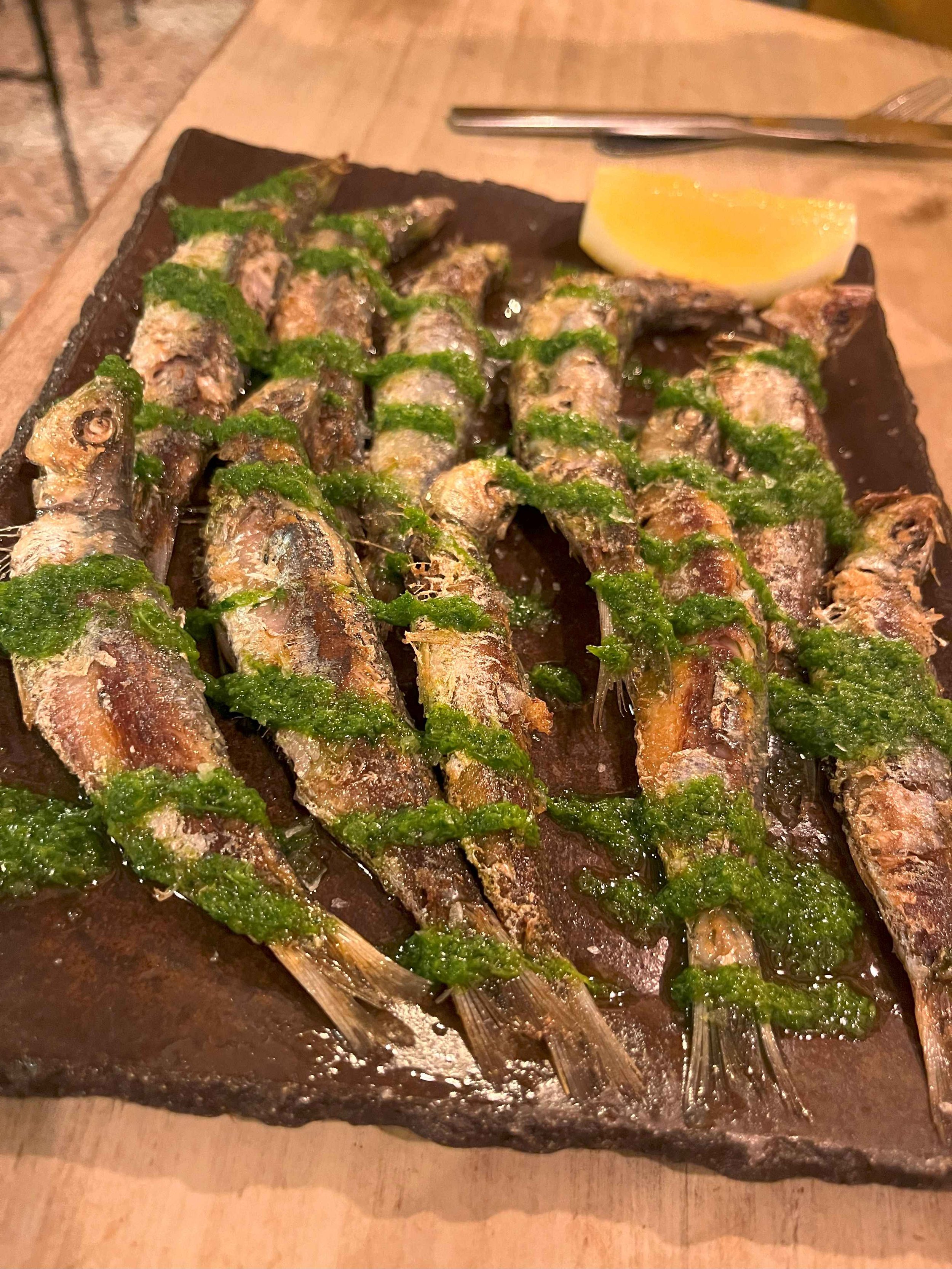Entierro de la Sardina
The Departed Sardine, Lying in Repose
Unbeknownst to us, the pre-Lenten season of Carnaval is celebrated in Barcelona as it is in many other locations around the world with their roots in the Mediterranean. Although not as vibrant as Venice, Rio de Janeiro, or New Orleans, it is nonetheless a time for fiestas but with little of the debauchery that accompanies other celebrations. In other words, we didn’t see anyone flashing boobs and butts or vomiting in the streets. Generally people have costume parties, much like at Halloween. There is one particular ritual that seems to be uniquely Spanish. That is, the “Entierro de la Sardina” or the Burial of the Sardine.
Why the sardine, one might ask. First, allow me to start by giving a brief history of my experience with sardines. Growing up, as a family we spent a great deal of time at the New Jersey shore, or “going down the shore” as they still say in Philadelphia even today. Most of the time we took day trips since it was a quick and affordable way to get out of town and the summer heat. We usually headed out just after dawn, my parents, five kids, and sometimes my grandmother. As we crammed into our sky blue 1967 Chevy Bel Air station wagon, joining us on the journey was a white metal cooler the size of a small dormitory fridge. Packed into the cooler were all sorts of necessary provisions for our road trip: a twelve-pack of my dad’s Schaefer beer, various cans of soda and iced tea as well as lunch fixings. Most of the food that went along were the usual staples of a picnic lunch such as deli meats, cheeses, egg salad, potato salad, and coleslaw. Yet there were various “delicacies” included that we wouldn’t normally get at home. These included Underwood Deviled Ham (my personal favorite), Lebanon Bologna (it was named for Lebanon, Pennsylvania where it was manufactured, although I mentioned it once to a Lebanese friend years later and he seemed revolted at the idea that anything like that would have been produced back in his home country), and sardines. Never let it be said that I didn’t like sardines, I did enjoy them and relished the chance to enjoy them on this rare occasion. King Oscar was our preferred brand and I particularly enjoyed the ones packed in tomato sauce.
The Hession Family’s Preferred Brand of Sardines
Unfortunately, one of the memories that stands out is the trip back from the beach. After devouring our lunches at the roadside picnic table, the leftovers were packed into the cooler and we headed to the beach. Hours later as the cooler sat in a hot car and the ice soon melted, much of what was in the cooler soon developed quite an aroma. There were still some drinks in the cooler and every time we opened it to reach in for a beverage, the stench wafted throughout the car. Pretty soon, my siblings and I associated the smell with those foods: my grandmother’s potato salad, hard-boiled eggs, and sardines. After a few of these trips, I began to develop a distaste for sardines which lasted well into adulthood.
My next true sardine experiences occurred at one of my favorite Baltimore restaurants, Tapas Teatro. It was here that I was first exposed to Spanish cuisine and all the dishes that are part of our everyday gastronomy here in Barcelona: patatas bravas, jamon iberico, croquettes, and sardines. Once at Tapas Teatro, I saw grilled sardines as a special on the menu and decided to give them a try. Sadly, they were preserved in salt and it was a bit much for my taste. The second time, I tried grilled fresh sardines and enjoyed them immensely. I was amazed that they could be more than just tiny fish crammed into a container. I next remember having them on a trip to southern France in 2007. It was also on that trip that I experienced the joy of fresh anchovies. Once again, I was surprised that their flavor was more than just the salty, squirmy bits that topped many strip mall pizza shops. Of course, this surprises Les since his affinity for anchovies and boquerones runs deep.
This brings us to recent history and the tinned fish craze, if it still is indeed a thing. When Les and I traveled to Portugal two years ago, one of the stops on our itinerary was the Conserveira de Lisboa (http://www.conserveiradelisboa.pt/ ), a specialty canned fish store. Needless to say, we went crazy buying all sorts of tinned fish. This was after watching an episode of Somebody Feed Phil from Lisbon. In that episode, he extolled the virtues of the tinned fish he was tasting at the Lisbon Time Out Market. We thought that we had tapped into something unique: canned fish with a gourmet twist. And not just sardines and anchovies but mussels, corvina, cockles, and razor clams. However, our newfound pleasure did not remain uncovered for long. Within the next year, the food press and blogs were all over this new fad. As expected, to me, it is becoming a victim of its own success. What appeared to be a relatively cheap way of enjoying delicious seafood without the hassle and expense became a luxury item. Restaurants now offer canned fish as appetizer or charcuterie board selections for prices north of $20 all for an item anyone can buy at a local supermarket for less than five bucks. Yes, we have reached peak tinned fish in the US.
This brings us to the Sardine Burial ceremony. According to the Spanish Tourism website, this is a ceremony that is celebrated predominantly in Murcia, culminating in a lavish festival during Easter Week (https://entierrodelasardina.com/plan-actividades-2024/ ). In other parts of Spain, including Barcelona, it is a culmination of the Carnaval festivities on Ash Wednesday. As for its origins, what I have gathered is that it began during a time of famine when meat was scarce but sardines were readily available. In order to preserve them, they were coated with salt and buried until such time as they were ready to be eaten. The Burial of the Sardine commemorates this. In fact its the subject of a famous Goya painting housed in the Real Academia de Bellas Artes de San Fernando (Royal Academy of Fine Arts of San Fernando) in Madrid.
Entierro de la Sardina
Francisco Goya (c. 1812-1819)
The burial service that Les and I attended with our classmates and teacher from the Spanish language school was held in the Barceloneta neighborhood of Barcelona in the plaza fronting the Església de Sant Miquel del Port (Church of Saint Michael of the Harbor). It was less somber than I expected although there were professional mourners who played their parts admirably.
Mourning the Dearly Departed Fish
After the solemn service, we then partook of bread, sardines, and wine offered by the good parishioners. A second glass of wine and we were then ready to process to the beach. There we buried our paper sardines in hopes that by doing so we’d have luck throughout the year. Still hungry and craving more sardines, Les and I headed out to find a spot for dinner. As what usually happens, we stumbled upon a local restaurant that might become a usual stop whenever we’re in Barceloneta.
Yummy Sardines for Dinner
Last week marked the start of our fourth month here in Barcelona. Gradually, we are becoming acclimated to the feel of the city and the culture. Events such as the Entierro de la Sardina are small but meaningful ways to connect with our new home. I can’t emphasize the importance of getting out and about and taking every opportunity to absorb all that you can in any new environment. It’s making our move seem worth it more every day!




